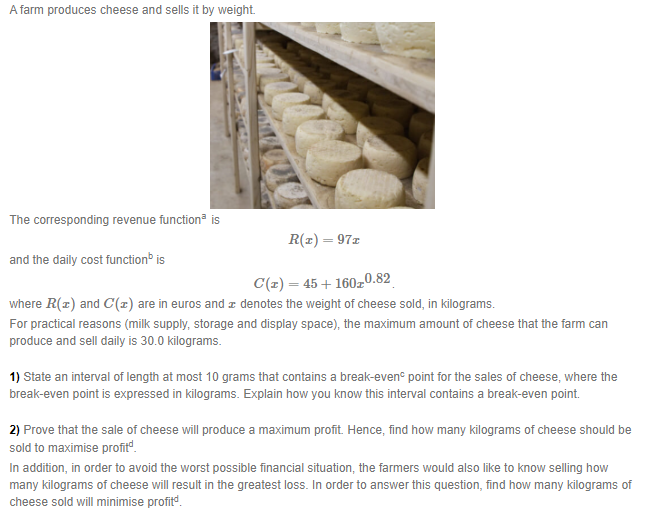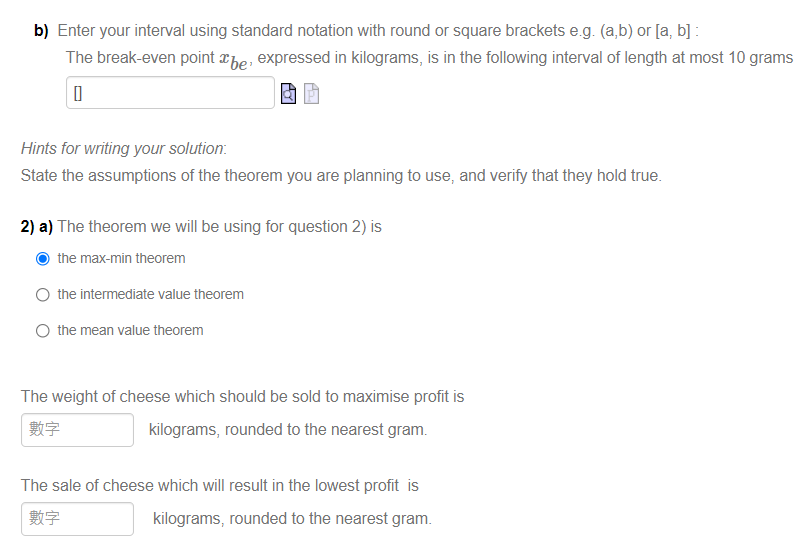Can anyone tell me how to solve those questions?


A farm produces cheese and sells it by weight. The corresponding revenue function is R(x) = 97.1 and the daily cost function is C(z) = 45+ 160.20.82 where R(I) and C (1) are in euros and a denotes the weight of cheese sold, in kilograms. For practical reasons (milk supply, storage and display space), the maximum amount of cheese that the farm can produce and sell daily is 30.0 kilograms. 1) State an interval of length at most 10 grams that contains a break-even point for the sales of cheese, where the break-even point is expressed in kilograms. Explain how you know this interval contains a break-even point. 2) Prove that the sale of cheese will produce a maximum profit. Hence, find how many kilograms of cheese should be sold to maximise profit In addition, in order to avoid the worst possible financial situation, the farmers would also like to know selling how many kilograms of cheese will result in the greatest loss. In order to answer this question, find how many kilograms of cheese sold will minimise profite. b) Enter your interval using standard notation with round or square brackets e.g. (a,b) or [a, b] : The break-even point Xbe, expressed in kilograms, is in the following interval of length at most 10 grams 0 Hints for writing your solution State the assumptions of the theorem you are planning to use, and verify that they hold true. 2) a) The theorem we will be using for question 2) is the max-min theorem the intermediate value theorem the mean value theorem The weight of cheese which should be sold to maximise profit is kilograms, rounded to the nearest gram. The sale of cheese which will result in the lowest profit is kilograms, rounded to the nearest gram. A farm produces cheese and sells it by weight. The corresponding revenue function is R(x) = 97.1 and the daily cost function is C(z) = 45+ 160.20.82 where R(I) and C (1) are in euros and a denotes the weight of cheese sold, in kilograms. For practical reasons (milk supply, storage and display space), the maximum amount of cheese that the farm can produce and sell daily is 30.0 kilograms. 1) State an interval of length at most 10 grams that contains a break-even point for the sales of cheese, where the break-even point is expressed in kilograms. Explain how you know this interval contains a break-even point. 2) Prove that the sale of cheese will produce a maximum profit. Hence, find how many kilograms of cheese should be sold to maximise profit In addition, in order to avoid the worst possible financial situation, the farmers would also like to know selling how many kilograms of cheese will result in the greatest loss. In order to answer this question, find how many kilograms of cheese sold will minimise profite. b) Enter your interval using standard notation with round or square brackets e.g. (a,b) or [a, b] : The break-even point Xbe, expressed in kilograms, is in the following interval of length at most 10 grams 0 Hints for writing your solution State the assumptions of the theorem you are planning to use, and verify that they hold true. 2) a) The theorem we will be using for question 2) is the max-min theorem the intermediate value theorem the mean value theorem The weight of cheese which should be sold to maximise profit is kilograms, rounded to the nearest gram. The sale of cheese which will result in the lowest profit is kilograms, rounded to the nearest gram








